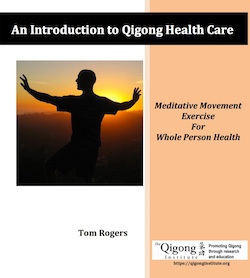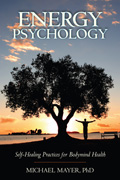Medical Benefits of Qigong Meditative Movement Exercise
Qigong forms involving movement, especially Tai Chi, have been strongly endorsed by numerous organizations including Harvard Medical School based upon years of research and practice (Wayne 2013) (Harvard 2019). A Veterans Administration review reported statistically significant effects for Qigong and Tai Chi for hypertension, falls outside of institutions, cognitive performance, osteoarthritis, chronic obstructive pulmonary disease, pain, balance confidence, depression, and muscle strength (Hempel et al., 2014). The American College of Sports Medicine (ACSM) recommends QT in their Position Stand for neuromotor fitness: "Neuromotor exercise training, sometimes called functional fitness training, incorporates motor skills such as balance, coordination, gait, and agility, and proprioceptive training. Multifaceted physical activities such as tai ji (tai chi), qigong, and yoga involve varying combinations of neuromotor exercise, resistance exercise, and flexibility exercise. Neuromotor exercise training is beneficial as part of a comprehensive exercise program for older persons, especially to improve balance, agility, muscle strength, and reduce the risk of falls” (Garber et al., 2011). A 2019 systematic review found independent research evidence that was sufficient to support Tai Chi performed as Qigong as a primary intervention for balance training and fall prevention (Klein et al., 2019).
A compelling body of research has also shown the benefits of Qigong and Tai Chi done as Qigong for a very wide range of health challenges and chronic conditions including, but not limited to, bone health, cardiopulmonary fitness, physical function, falls risk and balance, general quality of life, immune function and inflammatory responses, management of cancer, chronic obstructive pulmonary disease, Parkinson’s disease, cardiac and cardiovascular disease, mortality and stroke, blood pressure, stress and disease, heart function and microcirculation, asthma, respiration, allergies, neuromuscular disorders, cancer, use of drugs, anxiety, depression, and self-efficacy (Oh et al., 2020)(Sancier, 1996) (Sancier, 1996 Mar) (Feng et al., 2020) (Jahnke et al., 2010) (Klein et al., 2019) (Rogers et al., 2009) (McGee 2020). Meditative movement practices have also been recommended as a way to learn mindfulness for those who struggle to sit still during the more commonly taught mindfulness practices (Russell et al., 2015). Other researchers argue for conceptualizing and promoting physical activity as Mindfulness-Based Movement (Lucas, Porges, et al., 2018).
Feng F, Tuchman S, Denninger JW, Fricchione GL, Yeung A. Qigong for the Prevention, Treatment, and Rehabilitation of COVID-19 Infection in Older Adults [published online ahead of print, 2020 May 15]. Am J Geriatr Psychiatry. 2020;10.1016/j.jagp.2020.05.012. doi:10.1016/j.jagp.2020.05.012
Garber CE, Blissmer B, Deschenes MR, et al. American College of Sports Medicine position stand. Quantity and quality of exercise for developing and maintaining cardiorespiratory, musculoskeletal, and neuromotor fitness in apparently healthy adults: guidance for prescribing exercise. Med Sci Sports Exerc. 2011;43(7):1334-1359. doi:10.1249/MSS.0b013e318213fefb
Harvard Medical School. An Introduction to Tai Chi. 2019. Harvard Health Publishing
Hempel S, Taylor SL, Solloway MR, et al. Evidence Map of Tai Chi. Washington (DC): Department of Veterans Affairs (US); 2014
Jahnke R, Larkey L, Rogers C, Etnier J, Lin F. A comprehensive review of health benefits of qigong and tai chi. Am J Health Promot. 2010;24(6):e1-e25. doi:10.4278/ajhp.0810-LIT-248
Klein PJ, Baumgarden J, Schneider R. Qigong and Tai Chi as Therapeutic Exercise: Survey of Systematic Reviews and Meta-Analyses Addressing Physical Health Conditions. Altern Ther Health Med. 2019;25(5):48-53
Lucas AR, Klepin HD, Porges SW, Rejeski WJ. Mindfulness-Based Movement: A Polyvagal Perspective. Integr Cancer Ther. 2018;17(1):5-15. doi:10.1177/1534735416682087
McGee, Robert W. 2020. A Bibliography of Recent Medical Research on Qigong, Fayetteville State University, Broadwell College of Business and Economics, The Economics of Qigong Series, No. 2, August 31.
Oh B, Bae K, Lamoury G, et al. The Effects of Tai Chi and Qigong on Immune Responses: A Systematic Review and Meta-Analysis. Medicines (Basel). 2020;7(7):E39. Published 2020 Jun 30. doi:10.3390/medicines7070039
Rogers CE, Larkey LK, Keller C. A review of clinical trials of tai chi and qigong in older adults. West J Nurs Res. 2009;31(2):245-279. doi:10.1177/0193945908327529
Russell TA, Arcuri SM. A Neurophysiological and Neuropsychological Consideration of Mindful Movement: Clinical and Research Implications. Front Hum Neurosci. 2015;9:282. Published 2015 May 26. doi:10.3389/fnhum.2015.00282
Sancier KM. Medical applications of qigong. Altern Ther Health Med. 1996;2(1):40-46
Sancier K. Anti-Aging Benefits of Qigong. J. ISLIS. 1996 Mar. 14(1)
Wayne, P. 2013. The Harvard Medical School Guide to Tai Chi. Shambhala



